Science Highlights, January 7, 2015
Awards and Recognition
Materials Physics and Applications
Strength of microscopic magnetic interactions for emergent phenomena measured
Materials Science and Technology
Method to direct embedding of polycrystal plasticity in multiscale materials models
Awards and Recognition
David Andersson recognized for excellence in advancing nuclear fuels models and simulations
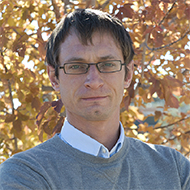
David Andersson
David Andersson (Materials Science in Radiation and Dynamics Extremes, MST-8) is a co-recipient of the 2014 Excellence Award from the leadership team of the DOE Nuclear Energy Advanced Modeling and Simulation (NEAMS) Program. Andersson, with Michael Tonks and Richard Williamson (Idaho National Laboratory), was recognized for “sustained leadership in developing multiscale mathematical models and computer simulations of nuclear fuels that have advanced the state of the art in the field and have added substantial value to the NEAMS Toolkit.”
The “NEAMS Toolkit” refers to new computation tools, based on first-principles physics models instead of status quo empirical math models, to provide the predictive simulation capability required for the development of high performing, safe, clean, and economical advanced reactor systems.
As part of DOE’s Office of Nuclear Energy, NEAMS supports research and development to study physical phenomena that drive the behavior of materials, captured by three-dimensional physics models and simulations, which could give designers of new fuels and reactor types the ability to predict how their new systems would behave in a range of conditions. In the area of new fuel systems—which could boost how efficiently a reactor produces power and how much nuclear waste it produces—there is an urgent need to speed up the steps of manufacturing fuel, building a fuel assembly, testing a fuel system in a reactor, and evaluating the results. These steps currently require years to accomplish. Andersson’s research aims to reduce the time and cost of screening different materials and design configurations, from the micro-structural level to individual pellets to entire rods and bundles. He uses atomistic simulations to develop material models for application in the MARMOT microstructure code and BISON fuel performance code.
Andersson earned a PhD in materials science and engineering from the Royal Institute of Technology (KTH), Sweden. He joined LANL in 2007 and is a scientist on MST-8’s Radiation Science, Nuclear Materials, and Fuels Modeling Team. His NEAMS research supports the Laboratory’s Energy Security mission area and the Materials for the Future science pillar through the development of models for nuclear reactor fuels.
The Office of Nuclear Energy’s mission is “to advance nuclear power as a resource capable of meeting the Nation’s energy, environmental, and national security needs by resolving technical, cost, safety, proliferation resistance, and security barriers through research, development, and demonstration as appropriate.” The NEAMS Awards, which also includes recognition for team building and innovation, are presented annually by the NEAMS leadership team, which includes its leadership council, national technical director, and the DOE Office of Advanced Modeling and Simulation. Technical contact: David Andersson
Fryer, Funsten, Gordon, Kiplinger, and Moore named Laboratory Fellows
Laboratory Director Charles McMillan appointed Christopher Fryer, Herbert Funsten, John Gordon, Jaqueline Kiplinger, and David S. Moore as Los Alamos National Laboratory Fellows. The Fellows comprise a distinguished organization that honors outstanding contributions to science and technology.Candidates are selected on the basis of:
- Sustained, high-level achievements in programs of importance to the Laboratory
- A fundamental or important discovery that has led to widespread use
- Having become a recognized authority in the field, including outside recognition and an outstanding record of publications
The Fellows organization was established in 1981 and includes technical staff members who have been appointed by the Laboratory director to the rank of Fellow in recognition of sustained outstanding contributions and exceptional promise for continued professional achievement. Fellows are limited to 2 percent of the Lab’s technical staff. They advise management on important issues, promote scientific achievement, and organize symposia and public lectures. The organization administers the annual Fellows Prize for Outstanding Research in Science or Engineering and the Fellows Prize for Outstanding Leadership in Science or Engineering. Technical contact: Melissa Robinson
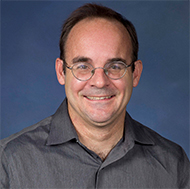
Christopher Fryer
Christopher Fryer (Computational Physics and Methods, CCS-2) is a widely recognized authority in astrophysics and an American Physical Society fellow. He received a PhD in astronomy from the University of Arizona, and joined the Lab as the first Feynman Fellow. Fryer has been at Los Alamos 15 years. He is recognized for his supernova core collapse modeling work, able to model, predict, and explain observations (e.g. from NASA’s Swift mission), which broke ground by moving to 3-dimensional modeling assimilation. Fryer has made valuable contributions to aid NASA in defining future astrophysics missions, and he sustains a wide range of collaborations with broader physics facilities. He is also involved in nuclear stockpile science, extending computer code capabilities especially in the areas of verification and validation.
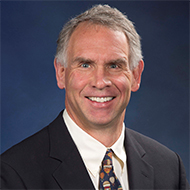
Herbert Funsten
He has provided outstanding scientific leadership at Los Alamos as the Intelligence and Space Research Division chief scientist, former director of the Center for Space Science and Exploration, and dedicated service to the Laboratory Directed Research and Development (LDRD) program. Funsten has received four NASA Group Achievement Awards (Van Allen Probes Mission Team, IBEX Science Team, IMAGE Mission Team, and Deep Space 1 Mission Team) and four LANL Distinguished Performance Awards [Van Allen Probes Mission Team, Space and Atmospheric Burst Reporting System (SABRS), SABRS Validation Experiment Team, and Mars Odyssey Team]. The Laboratory has honored him with a Women’s Career Development Award for his mentoring. Funsten received a PhD in engineering physics from the University of Virginia, and then joined the Lab as a postdoc in 1990.
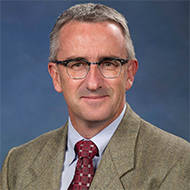
John Gordon
John Gordon (Inorganic Isotope and Actinide Chemistry) has 18 years of distinguished service at Los Alamos where he has become an international leader in inorganic chemistry and chemical transformations. He received a PhD in chemistry from the University of Notre Dame. Gordon has excelled in three disparate areas of inorganic chemistry; modern f-element chemistry, energy production and storage, and advances in conversion of biologically derived carbohydrates into chemical feedstocks and fuels. He has been named a Fellow of the American Association for the Advancement of Science (AAAS), a Fellow of the Royal Society of Chemistry, and he has received a Los Alamos Fellows Prize for Leadership in Science. Gordon served as a group leader in the Chemistry Division before returning to research in chemistry related to energy applications. He has served as mentor or co-mentor for 19 post-doctoral researchers, five of them becoming successful and independent Laboratory staff members. Gordon was recognized for this with a 2011 Exceptional Mentor Award.
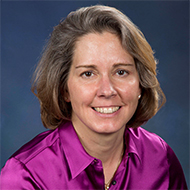
Jaqueline Kiplinger
Jaqueline Kiplinger (Inorganic Isotope and Actinide Chemistry, C-IIAC) is a pioneer in uranium and thorium chemistry, and her research has significantly expanded the broad understanding of actinide and lanthanide chemical bonding and reactivity. She received a PhD in organometallic fluorocarbon chemistry from the University of Utah and joined the Laboratory as the first Frederic Reines Fellow in 1999. Her synthetic innovations, often accomplished through chemistry previously thought impossible, have been adopted by researchers around the world. Kiplinger has been named a Fellow of both the Royal Society of Chemistry and the American Association for the Advancement of Science (AAAS) for her internationally recognized research. She has received the Lab’s inaugural Distinguished Postdoctoral Award, the Los Alamos Fellows Prize for Research, and the American Chemical Society’s 2015 F. Albert Cotton Award in Synthetic Inorganic Chemistry. Kiplinger’s scientific achievements have been paralleled by her 15 years of dedicated service to the Laboratory. Her innovative “green” methods for preparing actinide materials have earned two R&D 100 Awards and two NNSA Best-in-Class Pollution Prevention Awards. The Lab has recognized Kiplinger’s sustained excellence in mentoring with a Student Distinguished Mentor Award, STAR Award, and Postdoc Distinguished Mentor Award.
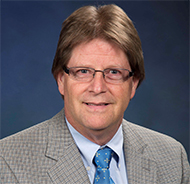
David S. Moore’s
David S. Moore’s (Shock and Detonation Physics, WX-9) laser shock experiments have opened the field of materials at extremes in pressure and temperature to a wide range of researchers. He received a PhD in physical chemistry from the University of Wisconsin-Madison. Moore joined the Lab as a Director’s Postdoctoral Fellow in 1980 and became a Technical Staff Member in 1981. His work has supported both the weapons program and the Threat Identification and Response directorate. He has made it possible to study shocked materials in research labs with tabletop lasers, as well as to use de minimus quantities of materials to map out their equations of state under extreme conditions. Moore has contributed to national security through his research on explosives detection and by his work with a team founding the Lab’s homemade explosives course. He is a Fellow in the American Physical Society and International Union of Pure and Applied Chemistry, and he has received a Los Alamos Fellows Prize for Leadership. Moore has mentored 17 postdocs and 20 students.
Toni Taylor joins American Physical Society Panel
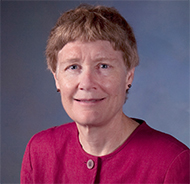
Toni Taylor
Taylor is an APS Fellow and has served as the 2014 chair of the APS Division of Laser Science executive committee. She is a former director-at-large of the Optical Society of America and a former topical editor of the Journal of the Optical Society B: Optical Physics. For the National Academies, she was a member of the Solid State Science Committee (now the Condensed Matter and Materials Research Committee) that advised the Board of Physics and Astronomy, and she chaired the National Academies’ Committee on Nanophotonics Applicability and Accessibility.
Taylor received a PhD from Stanford University, where she studied novel molecular spectroscopy. She joined LANL in 1986. Her research interests include ultrafast dynamical nanoscale processes in materials, development of novel optical functionality using metamaterials, and development of novel optics-based measurement techniques for the understanding of new phenomena. She has co-authored more than 300 papers and written 3 book chapters. Taylor is a Fellow of the American Association for the Advancement of Science, Optical Society of America, and LANL. She won the inaugural Los Alamos Fellows’ Prize for Outstanding Leadership in Science and Engineering.
Founded in 1899, the APS is dedicated to advancing and disseminating knowledge of physics through its research journals, scientific meetings, and education, outreach, advocacy, and international activities. APS represents over 50,000 members in academia, national laboratories, and industry in the U.S. and throughout the world. Technical contact: Toni Taylor
Kristin Omberg leads American Chemical Society’s fiscal committee
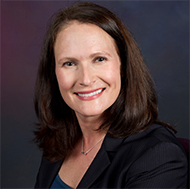
Kristin Omberg
The ACS, with more than 161,000 members, is a congressionally chartered nonprofit organization with a mission “to advance the broader chemistry enterprise and its practitioners for the benefit of Earth and its people.” It publishes 44 scientific journals, runs databases, convenes research conferences, and provides educational, science policy, and career programs in chemistry. ACS gives more than $22 million every year in grants for basic research in petroleum and related fields. Technical contact: Kristin Omberg
Chemistry
Rare multinuclear thorium complexes synthesized
Researchers in Chemistry (C) and Materials Physics and Applications (MPA) divisions have synthesized two rare multinuclear thorium (Th) complexes, which are formed by the unexpected carbon-oxygen bond cleavage of 1,2-dimethoxyethane (DME) by thorium iodide complexes. The isolation of well-defined oxo and alkoxide complexes resulting from actinide-mediated activation of DME is very rare. The journal Chemistry - A European Journal published the research, featured it as a frontispiece, and ranked the article as a Very Important Paper (VIP).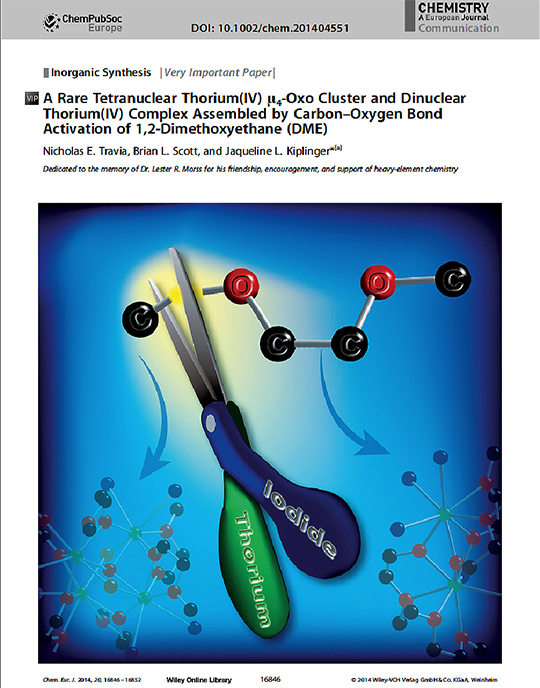
Figure 1. Journal frontispiece depicts an artist’s conception of DME being cleaved by a thorium-iodide bond, resulting in the multimetallic thorium complexes. Fontispiece art credit: Josh Smith (Chemistry Division Office, C-DO)
The research builds upon the team’s development of new routes to thorium halide starting materials that avoid the use of thorium metal as a reagent. The scientists previously reported that ThI4(DME)2 (2) can be prepared in high yield by halide exchange between ThCl4(DME)2 and trimethylsilyl iodide. In the present work, the team revealed that a mixed-halide compound ThCl4-xIx(DME)2 (3) is produced if the halide exchange is incomplete.
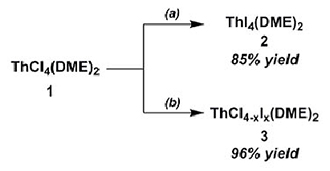
Figure 2. Synthesis of thorium tetrahalide complexes ThI4(DME)2 (2) and ThCl4-xIx(DME)2 (3): (a) 10 equivalents Me3SiI, toluene, 45°C, 4 h, vacuum. Repeat twice. (b) 10 equivalents Me3SiI, toluene, 45°C, 16 h.
Although DME is normally a robust ligand for actinide chemistry, this mixed-halide complex (3) and ThI4(DME)2 (2) rapidly react with DME under mild conditions (i.e., room temperature) to form the μ4-oxo cluster (4) and the dinuclear complex (5), respectively (Figure 3). These novel multimetallic complexes are formed reproducibly in good yield and result from the cleavage of multiple carbon-oxygen bonds.
Reference: “A Rare Tetranuclear Thorium (IV) µ4-Oxo Cluster and Dinuclear Thorium(IV) Complex Assembled by Carbon-Oxygen Bond Activation of 1,2-Dimethoxyethane (DME),” Chemistry - A European Journal 20, 16846 (2014); doi: 10.1002/chem.201404551. Authors include Nicholas E. Travia (Inorganic, Isotope and Actinide Chemistry, C-IIAC), Brian L. Scott (Materials Synthesis and Integrated Devices, MPA-11), and Jaqueline L. Kiplinger (C-IIAC).

Figure 3. The tetranuclear μ4-oxo complex Th4(µ4-O)(µ-Cl)2I6[κ2(O,O’)-µ-O(CH2)2OCH3]6 (4) and the dinuclear complex Th2I5[κ2(O,O’)-µ-O(CH2)2OCH3]3(DME) Th2I5(O(CH2)2OCH3)3(DME) (5, DME=1,2-dimethoxyethane) were formed from the C-O bond activation of DME mediated by thorium iodide compounds.
Educational Outreach
Los Alamos employees volunteer in local schools for Hour of Code
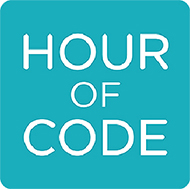
The Hour of Code is organized by Code.org, a public 501c3 non-profit dedicated to expanding participation in computer science by making it available in more schools, and increasing participation by women and underrepresented students. The organization believes that every student should have the opportunity to learn computer science, which helps nurture problem-solving skills, logic and creativity. By starting early, students will have a foundation for success in any 21st-century career path. A coalition of partners supports the Hour of Code — including Microsoft, Apple, Amazon, Boys and Girls Clubs of America, and the College Board. This is a nationwide effort to make computer science activities more accessible to young students.
The Supercomputing Challenge (a precursor to the Hour of Code) started with 25% female participation in 1990. The organizers worked hard at attracting female students and now have reached the 40% female participation rate. This year’s Challenge participants are about 55% non-white ethnicity. In 1990 the High School Supercomputing challenge began to interest students in the computer sciences. At that time, middle and elementary school aged children did not know how to code. Thanks to the efforts of organizations such as the Massachusetts Institute of Technology, which created the StarLogo and Scratch programming languages, this has changed. Students become interested in computing at a very young age due to programs like the Hour of Code.
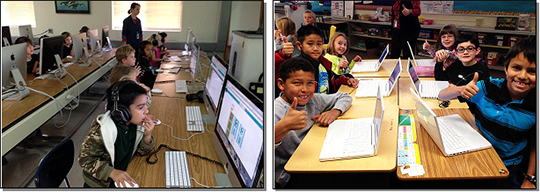
Photos. (Left): First grade students participate at Mountain Elementary School in Los Alamos. (Right): Students express enthusiasm at Pinon Elementary School in White Rock. Photo credit: David Kratzer
The Hour of Code has been instrumental in opening the mental barriers that previously existed in females and minorities about entering the world of computer science. For any industry to have such a preponderance of men compared with women and minorities causes an imbalance of ideas and progress. It is important that women and minorities are equally represented to maximize innovation, creativity and competitiveness.
Laboratory volunteers included M. K. Davis, S. Halverson, and A. Wollaber (Computer, Computational, and Statistical Sciences, CCS); S. B. Dermer, L. Fresquez, and S. K. Hooks (Departmental Computing Services, DCS); T. Cleland and H. Khalsa (Defense Systems and Analysis, DSA); A. Hayward (Engineering Services, ES); A. Awad, J. Brophy, L. A. Davey, R. Derrick, J. Ecker, J. Green, P. Khalsa, D. Kratzer, P. C. Lamborn, K. S. Protin, and P. Smith (High Performance Computing, HPC); L. Cartelli (Manufacturing Engineering and Technology, MET); C. Day and C. Unal (Nuclear Engineering and Nonproliferation, NEN); C. Ammann and C. Pacheco (Network and Infrastructure Engineering, NIE); V. Homan (Radiation Protection, RP); R. Hettinga (Science Resource Office, SRO); P. Fenimore (Theoretical, T); A. Cortez and E. Salazar (Weapon Systems Engineering, W); J. Favorite and M. Lorenc (X-Computational Physics, XCP).
Teachers reported that the students were very excited about the one hour of coding experience. To date 70 million students have tried Hour of Code. Volunteers at this year’s event have already requested volunteering for next year. More information: http://hourofcode.com/us and http://code.org. To volunteer for next year, contact Dave Kratzer
High Performance Computing
Global disease monitoring and forecasting with Wikipedia
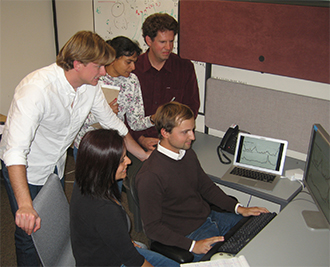
Photo. Researchers observe findings from their research on disease patterns. Back row (left to right): Geoffrey Fairchild, Alina Deshpande, and Reid Priedhorsky. Front row (left to right): Sara Del Valle and Nicholas Generous.
Infectious disease is a leading threat to public health, economic stability, and other key social structures. Efforts to mitigate these impacts depend on accurate and timely monitoring to measure the risk and progress of disease. Traditional, biologically-focused monitoring techniques are accurate but costly and slow. New techniques based on social Internet data, such as social media and search queries, are emerging in response. These efforts are promising, but important challenges in the areas of scientific peer review, data availability, breadth of diseases and countries, and forecasting hamper their operational usefulness. Los Alamos researchers have developed a method to analyze access logs from Wikipedia to monitor and forecast disease. PLoS Computational Biology published the findings.
The authors concluded that it is prohibitively difficult to solve the challenges of global disease monitoring and forecasting without a freely available, open data source. This conclusion contrasts with the bulk of prior work, which relies on closed or mostly closed data such as Google search queries or Twitter messages. Therefore, the team aimed to develop a path to a reliable, scientifically sound, global, operational disease surveillance system.
The team examined the disease monitoring and forecasting potential of a key (yet largely untapped) open data source: aggregated access logs from the online encyclopedia Wikipedia. Using linear models, language as a proxy for location, and a systematic yet simple article selection procedure, the scientists tested 14 location-disease combinations and demonstrated that these data feasibly support an approach that overcomes the challenges. The proof-of-concept yields models with r2 up to 0.92, forecasting value up to the 28 days tested, and several pairs of models similar enough to suggest that transferring models from one location to another without re-training is feasible.
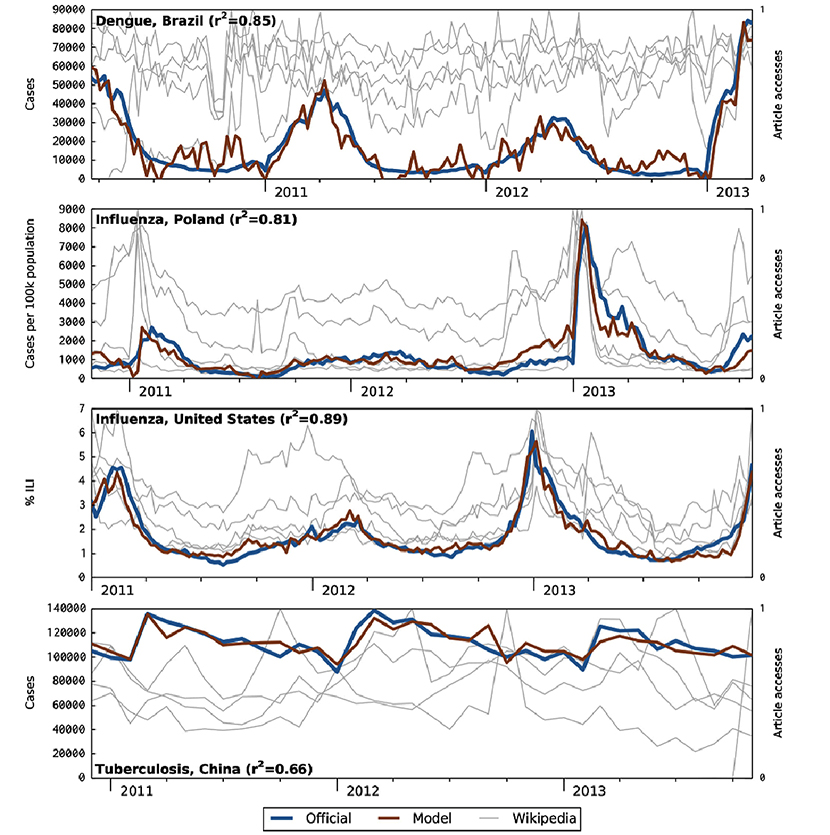
Figure 4. Official epidemiological data and nowcast (current status) model estimate (left Y axis) with traffic to the five most-correlated Wikipedia articles (right Y axis) over the 3-year study periods. The Wikipedia time series are individually self-normalized. The method’s good performance on dengue and influenza is consistent with prior work on these diseases. The results demonstrate the feasibility of Wikipedia access logs as a data source for disease monitoring.
Key to the success of the endeavor was QUAC (Quantitative Analysis of Chatter), a software package LANL developed for acquiring and analyzing social Internet content. QUAC can collect Twitter messages (called “tweets”), anonymized Wikipedia access logs, and Wikipedia edit histories. The software transforms these somewhat messy data into formats that are convenient for scientific research, including removing duplicates and sorting data into a consistent order. QUAC also resolves issues such as text encoding and very rare quirks. The open-source software is available on GitHub.
Human activity on the Internet leaves voluminous traces that contain real and useful evidence of disease dynamics. The researchers demonstrated that an emerging data source, Wikipedia access logs, has value for understanding the present and future of disease outbreaks. Moreover, the team revealed that the open data have critical advantages over previous data sources because they enable proper scientific peer review and can be applied more easily to a diversity of diseases and countries. The method has potential to “train” a computer model using public health data in one location and applying it in another. The work enabled the researchers to define a new research agenda for the field, designed to produce an operational disease monitoring and forecasting system that is effective, robust, and globally comprehensive. Such a system could save lives, alleviate suffering, and reduce the social and economic impacts caused by disease burden.
Reference: “Global Disease Monitoring and Forecasting with Wikipedia,” PLoS Computational Biology 10(11): e1003892 (2014); doi:10.1371/journal.pcbi.1003892. The Lab’s Mathematical and Computational Epidemiology Team led by Sara Del Valle (Energy and Infrastructure Analysis, DSA-4) and the Information Analysis and Integration Team led by Alina Deshpande (Data Systems Analysis and Surveillance, DSA-3) conducted the research. Authors include Nicholas Generous and Alina Deshpande (DSA-3), Geoffrey Fairchild and Sara Del Valle (DSA-4), and Reid Priedhorsky (System Integration, HPC-5).
The NIH/National Institute for General Medical Sciences/Models of Infectious Disease Agent Study and the Defense Threat Reduction Agency (DTRA), Joint Science and Technology Office for Chemical and Biological Defense funded the research. Laboratory Directed Research and Development (LDRD) supported the development of the QUAC software, and the Laboratory’s Institutional Computing Program provided high performance computing resources. The work supports the Lab’s Emerging Threats and Opportunities strategy, the Global Security mission area, and the Information, Science, and Technology (this project required large-scale data-intensive computing resources) and Science of Signatures (novel signatures of disease spread) science pillars. Technical contact: Reid Priedhorsky
Materials Physics and Applications
Strength of microscopic magnetic interactions for emergent phenomena measured
Microscopic magnetic interactions are at the origin of various emergent phenomena such as superconductivity, magnetic frustration, ferromagnetism and magneto-electric coupling that are important for current and future applications ranging from computing to alternative energies to transportation. To understand these phenomena, scientists work on quantifying and ultimately tuning magnetic interactions. A family of cerium (Ce)-based materials that can be tuned to exhibit superconductivity and complex magnetism has served as a test bed to study such emergent phenomena since their discovery at Los Alamos in 2000. By combining neutron spectroscopy and theory, researchers from Los Alamos National Laboratory and Oak Ridge National Laboratory’s Spallation Neutron Source have uncovered the strength of the magnetic interactions in these materials for the first time. Physical Review Letters published the findings.
Microscopic magnetic interactions are the forces between neighboring magnetic moments—that is, microscopic “compass needles” that sit on every atom in a magnetic material. Scientists have shown for the first time that the magnetic interactions in the material CeRhIn5 that is part of this family are “frustrated,” because the constraints resulting from magnetic forces on the nearest and next-nearest magnetic moments cannot be fulfilled at the same time. Because researchers believe that magnetic interactions in this family of cerium materials could play an important role for the emergence of superconductivity, this result provides new insight into the complex interplay between frustrated magnetism and superconductivity.
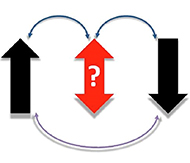
Figure 5. When the magnetic interactions between nearest (blue arrows) and next-nearest (purple arrow) neighbor atoms have antiparallel alignment of the respective magnetic moments, the resulting magnetic order is frustrated, because the magnetic moment (denoted in red) cannot satisfy both requirements simultaneously. This scenario is observed in the cerium-based material CeRhIn5.
Reference: “Magnitude of the Magnetic Exchange Interaction in the Heavy-Fermion
Antiferromagnet CeRhIn5,” Physical Review Letters 113, 246403 (2014); doi: 10.1103/PhysRevLett.113.246403. Authors include Pinaki Das, Nirmal J. Ghimire, Filip Ronning, Eric D. Bauer, Joe D. Thompson, and Marc Janoschek (Condensed Matter and Magnet Science, MPA-CMMS); Shizeng Lin and Cristian D. Batista (Physics of Condensed Matter and Complex Systems, T-4); Kevin Huang (University of California, San Diego and MPA-CMMS); and Georg Ehlers (Oak Ridge National Laboratory)
The DOE Office of Basic Energy Sciences, Division of Materials Sciences and Engineering and the Laboratory Directed Research and Development (LDRD) program sponsored different aspects of the LANL work. A Seaborg Institute Research Fellowship funded Huang. This effort to understand emergent phenomena in functional materials aligns with grand challenges outlined by the DOE Basic Energy Sciences and the Lab’s Materials Strategy. The research supports the Lab’s Energy Security mission area and Materials for the Future science pillar. Technical contact: Marc Janoschek
Materials Science and Technology
Method to direct embedding of polycrystal plasticity in multiscale materials models
A team of Lawrence Livermore National Laboratory (LLNL), Los Alamos National Laboratory, and Cornell University scientists published research on multiscale materials modeling that provides a framework for embedding polycrystal plasticity models in component-scale simulations. The framework overcomes the high computational cost associated with such simulations. While specific applications in this work are focused on the deformation of titanium specimens, including the effects of deformation twinning, the framework offers a path to develop computationally efficient multiscale embedding of polycrystal plasticity for a very general class of structural materials in simulation codes for engineering applications. This research appeared in the journal Computational Methods in Applied Mechanics and Engineering.
The method demonstrates the numerical implementation of an efficient way to embed microstructure-sensitive material models in component-scale simulations of mechanical response.
The need for numerically tractable models to capture anisotropic plastic flow, such as in simulations of metal forming, drives this effort.
The work unifies three separate pre-existing models: 1) LANL’s viscoplastic self-consistent (VPSC) model, widely used for the prediction of mechanical behavior of polycrystalline aggregates; 2) Cornell’s discrete harmonic (DH) representation of crystallographic texture, including the treatment of lattice reorientation due to slip and twinning activity at single crystal level; and 3) LLNL’s adaptive sampling (AS) model, a numerical strategy that mitigates the computational cost of direct embedding by building on-the-fly a database of material response, achieving two or more orders of magnitude in wall-clock speedup, compared with direct interrogation of the lower length-scale models. The team integrated all three models into LLNL’s flagship Finite Element code ALE3D.
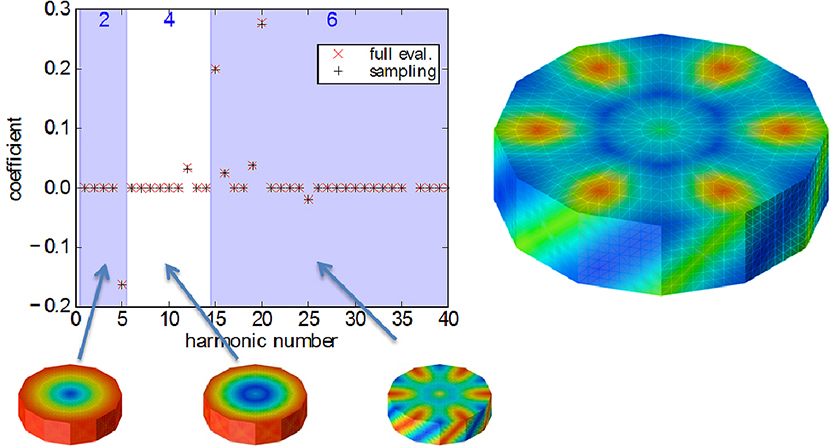
Figure 6. (Left): Results for evolved harmonic coefficients using full fine-scale evaluations versus adaptive sampling, including harmonic modes of degree 2, 4 and 6, over the hexagonal fundamental region of Orientation Distribution Function (ODF) space. (Right): ODF predicted for a deformed titanium polycrystal.
Reference: “The Use of Discrete Harmonics in Direct Multi-scale Embedding of Polycrystal Plasticity,” Computational Methods in Applied Mechanics and Engineering 283, 224 (2015); doi: 10.1016/j.cma.2014.09.017. Researchers include N.R. Barton and J.V. Bernier (LLNL), R.A. Lebensohn (Materials Science in Radiation and Dynamics Extremes, MST-8), and D.E. Boyce (Cornell University).
This work is an example of Science on the Roadmap to MaRIE, the Laboratory’s proposed experimental facility for Matter-Radiation Interactions in Extremes. The development of such novel theory, modeling, and computation tools, integrated with the wealth of experimental data that would come from MaRIE, could provide an unparalleled capability to understand, predict, and control materials behavior under extreme conditions.
The DOE Office of Science, Office of Advanced Scientific Computing Research funded this work through LANL-LLNL’s joint Exascale Co-Design Center for Materials in Extreme Environments (ExMatEx). The work supports LANL’s Energy Security mission area and the Materials for the Future science pillar by providing a new computational tool to enable the science and engineering required to establish novel design principles and manufacturing processes for advanced materials. Technical contact: Ricardo Lebensohn
Physics
“Surprising discrepancy” discovered in temperature of shocked aerogel foam
Silica aerogel (SiO2) is an important low-density pressure standard used in many high energy density experiments, including the novel technique of shock and release, and for experiments seeking to understand radiation flow. Researchers have reported equation of state (EOS) measurements of shocked silica aerogel foam at the OMEGA laser facility at in New York. The measured temperature using streaked optical pyrometry in shocked aerogel foam was systematically lower than suggested by theoretical calculations, an “especially surprising discrepancy,” they said, at even the lowest temperatures measured (around 2–3 eV). Physical Review E published the paper.
The equation of state of light elements at high densities and moderate temperatures falling into the warm dense matter (WDM) regime is essential to understanding the structure of Jovian planets as well as inertial confinement fusion (ICF) experiments. In these systems, quantum degeneracy and strong interparticle forces are significant, making the theoretical description of warm dense matter extremely challenging. This study presents results from a combination of experimental techniques used to characterize thermodynamic properties of SiO2 aerogel foam at warm dense conditions created by a laser of variable intensity driving a strong shock.
Low density foams are utilized in a wide range of high energy density (HED) experiments and plasma physics-related work, including laboratory astrophysics, planetary science, basic science, and shock physics. The foams have also been used as pressure standards for other equation of state experiments. A particularly important use is for radiation transport experiments, where these materials have become a standard for testing current methods and approaches to understanding radiation flow. Because many of these high energy density experiments are highly integrated, they must rely on simulations for the comparison with models. In many instances, the simulation results can be sensitive to uncertainties in the equation of state models of these low-density materials. Therefore, accurate measurements of the equation of state and especially of the temperature of the material at a given state are needed to restrict the modeling of these experiments, particularly the radiation flow experiments.
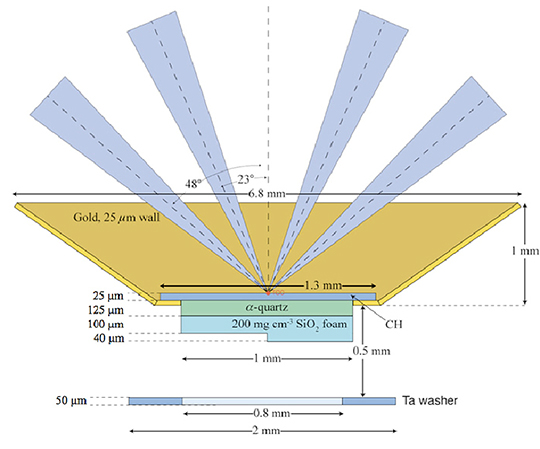
Figure 7. Schematic of the target setup, which includes aerogel foam inside a 25-μm-thick gold cone. LANL staff fabricated the target.
The researchers examined the use of x-ray Thomson scattering to measure the shocked foam’s temperature because optical pyrometry is problematic for measuring temperature in these regimes. The team compared the experimental results with hydrodynamic simulations and equation of state models. The scientists found that the measured temperature was systematically lower than suggested by theoretical calculations. They performed highly resolved simulations with LANL’s RAGE code to explore the details of the shock propagation in the foam coupled with the emission from the shock front. These simulations indicate that a radiative precursor propagates ahead of the shock into the unshocked foam, which then emits radiation at the photon energies measured by the diagnostic. This thin, radiative precursor layer exists at a reduced temperature from the bulk of the shocked material and thus reduces the corresponding temperature interpreted from the radiation. The dominant physical mechanism producing this effect is the relatively long mean free path of the radiation from the shock compared with the measured radiation. It is somewhat surprising that this discrepancy occurs at even the lowest temperatures measured (around 2–3 eV). At lower shock velocities, the lower value of aerogel reflectivity affects the result. If the value of R is corrected using the quantum molecular-dynamics calculations, the resultant temperatures from the streaked optical pyrometer will be closer to the QMD and SESAME equation of state at temperatures below 3 eV.
Reference: “Temperature Measurements of Shocked Silica Aerogel Foam,” Physical Review E 90, 033107 (2014); doi: 10.1103/PhysRevE.90.033107. Authors include Katerina Falk and David Montgomery (Plasma Physics, P-24), Chris Fryer (Computational Physics and Methods, CCS-2), Carl Greeff (Physics and Chemistry of Materials, T-1), Aimee Hungerford (Computational Physics, XCP-DO), Derek Schmidt and Jim Williams (Polymers and Coatings, MST-7), Daniel Sheppard (Materials and Physical Data, XCP-5), C. A. McCoy (University of Rochester), and John Benage (formerly P-24, now Sandia National Laboratories). The Target Fabrication Team in the Polymers and Coatings Group (MST-7) fabricated the targets used in the experiments. A team from LANL, the University of Rochester’s Laboratory for Laser Energetics, and Sandia National Laboratories conducted the research.
The DOE NNSA funded the investigation, which supports LANL’s Nuclear Deterrence and Energy Security mission areas and the Nuclear and Particle Futures science pillar by providing more accurate measurements that could lead to more precise models of radiation flow and equation of state for foams. Technical contact: David Montgomery












